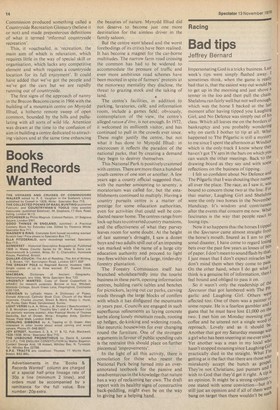Nanny in a National Park
Antonia Martin
The Brecon Beacons, one of the most beautiful wild landscapes in Wales, is well on the way to acquiring the title of 'the London foothills'. A recent survey has found that south-eastern England is the area's most important 'source region' for holiday visitors: unofficially, the Black Mountains on the eastern fringes have long been known as the Hampstead Highlands because of the number of fashionable second home owners who have established themselves there. Ironically enough, such popularity is one aspect of a National Park success story that is, on another level, a record of failure, as promotion of tOurism and preservation of the countryside come into active conflict.
The Beacons were not designated as a park until 1956, and for several years afterwards the only signs of their new status were the familiar symbols on the roadsides as you entered. Even as recently as fifteen years ago, the Beacons remained almost the private preserve of the southern Welsh, protected by the fearsome reputation of South Wales as the place with a coaltip at the end of every garden. The busiest times on the mountain roads were Thursday afternoons, early closing day in the valleys, when shopkeepers and their wives would drive over the Beacons to Brecon and a quiet tea.
The opening in the early 'sixties of the Severn Bridge, followed a few years later by the extension of the M4, was the catalyst that prompted the rapid and now menacing popularity of the Park, whose 519 square miles stretch from Offa's Dyke in the east to Llandeilo in the west. Whereas up to now the watchword has been 'let 'em all come', there are signs that saturation point is near. A newly-issued draft report on the future of the Park, that is to be presented to the Government next spring, bears all the evidence of brakes being hurriedly applied.
Some of the most significant proposals in the report, compiled by the Park planning officer on behalf of the Brecon Beacons National Park Committee that was set up in 1974, suggest discouragement of publicity that would bring in even more visitors; a clamp-down on more holiday accommodation; restrictions on the building of new houses and second homes for people living and working outside the Park; closer scrutiny of camping and caravan sites; and the closing of some minor country roads to all non-essential road traffic by downgrading them to public footpaths. All these proposals point in one direction—the nearimpossibility of reconciling the twin statutory functions of a national park, to preserve and enhance natural beauty and at the same time to promote its enjoyment by the public.
Unfair as it may seem to the planners, the Beacons appear to the ordinary observer to have fared far worse since they have had an elaborate bureaucratic apparatus protecting them than they did when they were left more or less to their own devices. I was lucky enough to be born only ten miles from Pen-y-Fan, the dominating peak in the Park, and I have watched a wild, free landscape become the playground of theorists, seen it become gradually tamed, suburbanised and subordinated to the car. I walked over the Beacons, rode over them, climbed them, picnicked in them, had the fun of discovering whole expanses that were new to me yet known to earlier generations who had thoughtfully allowed me to make finding them my own personal odyssey.
This was before nanny came on the scene and littered it with 'way-marked walks', 'nature trails', 'picnic areas', 'viewpoint indicators', information centres full of glossy literature and the inevitable 'toilet facilities'. It was before the Countryside
Commission produced something called a Countryside Recreation Glossary (believe it or not) and made preposterous definitions of what it termed 'informal countryside recreat ion'.
This, it vouchsafed, is 'recreation, the main aim of which is relaxation, which requires little in the way of special skill or organisation, which lacks any competitive element and which requires a countryside location for its full enjoyment'. It could have added that we've got the people and we've got the cars but we are rapidly running out of countryside.
The first signs of the approach of nanny in the Brecon Beacons came in 1966 with the building of a mountain centre on Mynydd Illtud, a hitherto remote sweep of open common, bounded by the hills and pullulating with all sorts of wild life. Attention was drawn at the time to the confusion of aim in building a centre dedicated to attracting visitors and at the same time enhancing



































 Previous page
Previous page